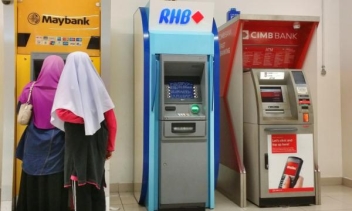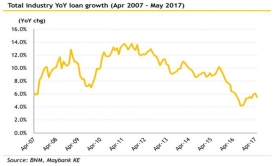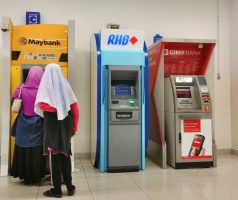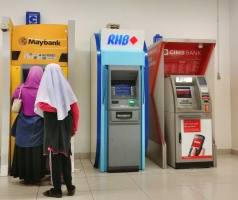Malaysia
Public Bank's profit up 6% to US$310m in Q2
This brings the bank's profit to US$602m in the first half of 2017.
Chart of the Week: Check out Malaysian banks' loan growth in the past 10 years
Industry loan growth stands at 2.8% on an annualised basis.
Here's why growth in Islamic banking will slow in the coming years
The slump in oil prices is one factor.
What could boost growth of the Malaysian Islamic banking sector?
The country has US$150b in Islamic financial assets.
Competition amongst smaller Islamic banks set to intensify
That is if the Malaysia Building Society-Asian Finance merger will push through.
Malaysian banks' absolute gross impaired loans up 7.1% in May
The banks' asset quality is still deteriorating.
The 9th BankTech Asia to showcase solutions from five fintech firms
The event will be held in Kuala Lumpur from July 5 to 6.
Malaysian banks weather decreasing customer loyalty as fintech booms
Non-banks are enjoying increased customer attention and retention. Transaction values rose a staggering 21% in Malaysia’s startup ecosystem over the past year, indicating relentless support for further innovation and acceleration of the fintech market. As money pours into the fintech space in the country, Malaysian banks are increasingly being threatened to widen their ecosystems and cross-sell more products as fast as the likes of Ping An. With the rise in diversified and exciting products from fintech startups, clients are slowly easing out their traditionally preferred banks in favour of these non-traditional providers. The number and extent of transactions with a non-bank have simultaneously increased with the volume of digital disruptions happening within a country, and Malaysia is no exception to the increasing numbers of fintech clients especially in Kuala Lumpur. Banks have begun looking at increasing digital transformation needs in capital allocation planning for the next two to three years, according to Liew Nam Soon, managing partner for financial services in ASEAN, Ernst and Young, and 85% of those that EY surveyed have established a digital transformation function with executive positions such as chief of fintech, chief of data, and chief of innovation. During the Kuala Lumpur leg of the Asian Banking and Finance Retail Banking Forum 2017, Nam Soon emphasised that banks need bold strategies to compete in today’s new normal environment, where the digital ecosystem continues to emerge and where financial institutions maximise innovations around robotic process automation, robo-advisory, artificial intelligence, chat bots, application program interface (API), and blockchain, among others. Loyalty blues As traditional banks and startups overtake each other in the race to producing the newest digital product, customers have loosened up and become more flexible in the way they do banking. Clients these days swarm to where the latest digital trend is, and when their preferred bank is not ready to provide them what’s hot in the market, they can easily transact with another bank or another provider. “What we see in Malaysia, a lot of your customers are actually buying products from other banks, 50% of products purchases comes from another bank. Around >50% of purchases go to competing banks weighted towards higher margin products and share of digital channels. Banks need to quickly address drivers of detraction since falling switching costs may exacerbate hidden defection,” said Charles Lambert, partner, Bain & Company. According to Lambert, these customers are very easy to identify. Customers with multiple products and those who have been with the bank for a long time but have a low net promoter score (NPS) over the years are the ones who tend to shop around. Lambert added that two in five retail bank customers would switch if the process were easier, which is a very big possibility in the future. “Malaysia's increasing dependence on digital channels reduces attachment to traditional ways of banking. As traditional banks embrace digital channels, branch closures reduce NPS of omnichannel and branch-only customers whose needs are no longer met. The effects of these forces on defections may be amplified by possible changes to regulation as the financial regulators in Malaysia review financial regulations to adapt to fintech development,” Lambert added. Despite challenges on the digital side and increasing interactions with fintechs, Malaysian clients have started to prefer local banks over foreign ones. When Bain & Company surveyed Malaysian banks three years ago, the top bank which had the highest customer loyalty score was a foreign bank. Over the last few years and as local banks tried to enhance presence and innovation, Malaysia’s banking industry saw a rise in the net promoter score (NPS) among local banks. Fast forward to 2017, the NPS leader is now a Malaysian bank. Meanwhile, Nam Soon said banks and non-banks alike will always have problems with loyalty in this day and age. According to him, enforced loyalty will probably do the trick by increasing customer interactions and creating a unique ecosystem which customers will find indispensable in their daily activities. The fast moving consumer goods experience shows that more firms can create more reasons for customer interaction and thereby, create loyalty. “If you only interact with a customer once a month, how loyal can that customer be? If you can catch a customer to do a number of things with you across a number of things with you across a number of products, that's a way to make loyalty go up. We all know a lot of money goes into loyalty programs and not all of them yield the expected return,” Nam Soon added. Making mobile work As fintechs continue to take hold of the financial industry, banks have deemed it strategic to partner instead of compete. Several Malaysian banks are now employing the services of startups and fintech companies, with the aim of bringing banking expertise and fintech innovation together. Helmi Hasan Baraja, a consumer apps expert and mobile development architect, said that the number of mobile phone internet users in Malaysia will go up to 21 million in 2020, hence banks should focus on developing their apps as a tool to keep their customers. “Back in the day, we focused on the website, the retail banking platform, now we switched to the mobile banking platform so if we look into the mobile platform, the traditional way is the topdown, we design for the desktop, then we design for the laptop and lastly mobile. The drawback of this approach is we focus more on the desktop. More people look into smaller screens now. We need a bottom up approach,” added Baraja. Developers call this the Mobile First design, where banks start small and scale up. Instead of putting everything on the screen, developers focus on the design and the speed of the app, two characteristics that users nowadays focus on. Baraja said most banks in Malaysia need to upgrade, as they usually have a desktop website which is not perfect for mobile navigation. On-the-go customers who do not like the mobile app or the mobile website of a company tend to switch to other banks who can cater their needs. A survey by Apigee shows that 44% of users delete a mobile app immediately if it did not perform as expected. Baraja said that these lost transactions over mobile apps not only result in lost revenue for banks, but have a detrimental impact on customer loyalty and brand reputation. Ultimately, it is a lose-lose situation. “In the end, how to go about driving more loyalty in your customer base, there is no secret recipe. And it's a combination of things. It's driving excellent customer experience, it's making it easy for customers, and it's making them embrace the digital revolution, going mobile fast, pushing the channel and executing well through mobile and online channel, teaching them support. It's good to have the tools, but it's also good to have the banking processes follow suit,” Lambert added.
Malaysian banks' loans loss coverage ratio on a persistent decline since 2014
It has declined to 74.4% from 4Q14's peak of 91.1%.
Why non-interest income is Malaysian banks' key earnings driver
Analysts' pre-provision operating growth forecast of 8% depends on its recovery.
Chart of the Week: Check out Malaysian banks' total deposits vs CASA growth
System deposits are on a gradual uptrend.
Malaysian banks' loan growth hits 6.1% in April
Business loans grew 7.5%.
RHB and AmBank gets go ahead to discuss possible merger
Both banks already entered into an exclusivity agreement to finalise merger terms.
Maybank's net profit up 19.3% to US$397m in Q1
Net operating income also increased 3%.
CIMB's net profit up 45% to US$275m in Q1
Find out what the positives were for the quarter.
RHB's asset quality stable in Q1
Gross impaired loans ratio slipped to 2.39%.












 Advertise
Advertise




















